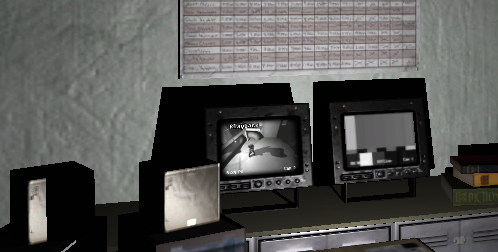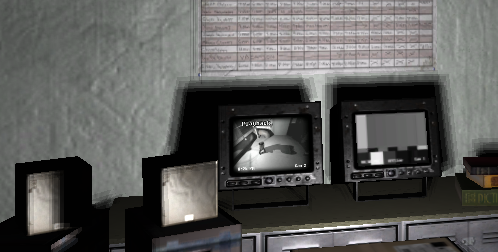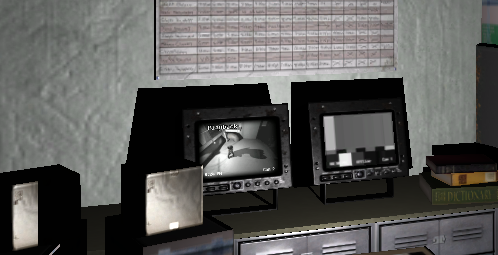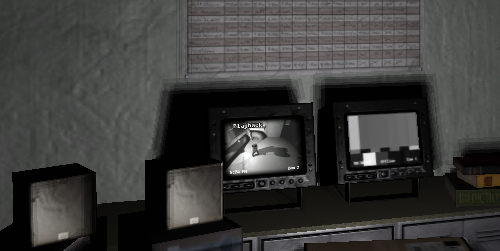F.E.A.R. GPU Performance Tests: Setting a New Standard
by Josh Venning on October 20, 2005 9:00 AM EST- Posted in
- GPUs
The Failure of Soft Shadows and Parallax Mapping
Soft Shadows
We've seen how soft shadows can be used effectively in games like The Chronicles of Riddick, and Monolith has decided to add this as an option in FEAR. Used correctly, soft shadows greatly enhance lighting in a game by giving shadows cast by objects different levels of darkness making them more realistic. This process can take up a lot of processing power however, and that's no exception for FEAR.
Basically, soft shadows are an effect that show how shadows tend to fade at the edges or cast overlapping lines on walls or objects depending on different factors such as light angle and distance. If you've ever made a shadow-puppet, you can see this clearly, as multiple outlines of your hand shadow overlap on the wall with varying degrees of darkness (depending on the light source). And if you were to move your hand closer or farther away from the light, you can see how the soft shadows change dynamically.
The idea is to capture this effect in a game environment, but as any programmer would know, translating this to a game engine can be a very complex undertaking. Not only that, but as we mentioned before, calculating multiple shadows in real time can quickly become a major leech of processing power. With FEAR, we've seen how big of a performance hit that we had when we enabled soft shadows, but you may wonder, "does the effect at least look good?"
The short answer is "no". The way that FEAR incorporates soft shadows ends up looking unrealistic; more stratified and strange than soft. It simply looks as though the game draws multiple shadows at the edges of objects and offsets them up, down, left and right very slightly at different degrees of darkness regardless of the light source. This wouldn't be so bad if the multiple shadows were not readily noticeable as such. It also would have been nice if the "blur factor" were more dynamic; in other words, moving the shadows closer together or farther apart given where the object (say an enemy soldier) is in relation to the light sources and shadowed surfaces.
This is difficult to understand until you see it happening in the game, but you can get a better idea of it by looking at a few pictures. We took some screen shots of a scene with and without soft shadows enabled with both NVIDIA and ATI cards. Please ignore the slight lighting and position differences of these screens.
Parallax Mapping
While the detailed textures, excellent lighting, well done static and dynamic shadows (in spite of the soft shadow issue), large intricate particle systems, and various beautiful effects of FEAR come together to form an immersive and fluid graphical experience, there are a few caveats. To their credit, Monolith was very aggressive with the features that they included and are on the leading edge of technology. The use of a deep parallax mapping algorithm to represent damage is a very cool idea, but the implementation used in FEAR doesn't include key features such as self-occlusion and self-shadowing. When passing a wall with a chunk blown out, the hole will swim around, flatten out, and eventually look like unidentifiable goo stuck to the wall as the angle gets very steep.
The parallax mapping used looks great from angles where the entire interior of a hole can be seen. The problem occurs at viewing angles where a near edge would need to block the view of part of (or the entire) interior of the indention. Rather than occluding anything, parts of the texture that should become invisible are still shown (albeit distorted). This completely destroys the illusion of depth at steep angles by making the texture kind of swim until it totally loses its three-dimensionality. There are algorithms available that can represent correctly self-occlusion in parallax mapping. While we can appreciate cheaper parallax mapping algorithms as a kind of upgraded bump mapping, dramatic surface deformation should either be done more correctly or not at all in cases where the viewer can move to angles that break the effect.
But again, we would love to give credit where credit is due. We would rather see game developers experiment with new technology and put something out there than let the true power of our graphics cards remain dormant. Monolith was ahead of the curve with the graphics in Tron 2.0, and they haven't let us down with the quality of FEAR.
Soft Shadows
We've seen how soft shadows can be used effectively in games like The Chronicles of Riddick, and Monolith has decided to add this as an option in FEAR. Used correctly, soft shadows greatly enhance lighting in a game by giving shadows cast by objects different levels of darkness making them more realistic. This process can take up a lot of processing power however, and that's no exception for FEAR.
Basically, soft shadows are an effect that show how shadows tend to fade at the edges or cast overlapping lines on walls or objects depending on different factors such as light angle and distance. If you've ever made a shadow-puppet, you can see this clearly, as multiple outlines of your hand shadow overlap on the wall with varying degrees of darkness (depending on the light source). And if you were to move your hand closer or farther away from the light, you can see how the soft shadows change dynamically.
The idea is to capture this effect in a game environment, but as any programmer would know, translating this to a game engine can be a very complex undertaking. Not only that, but as we mentioned before, calculating multiple shadows in real time can quickly become a major leech of processing power. With FEAR, we've seen how big of a performance hit that we had when we enabled soft shadows, but you may wonder, "does the effect at least look good?"
The short answer is "no". The way that FEAR incorporates soft shadows ends up looking unrealistic; more stratified and strange than soft. It simply looks as though the game draws multiple shadows at the edges of objects and offsets them up, down, left and right very slightly at different degrees of darkness regardless of the light source. This wouldn't be so bad if the multiple shadows were not readily noticeable as such. It also would have been nice if the "blur factor" were more dynamic; in other words, moving the shadows closer together or farther apart given where the object (say an enemy soldier) is in relation to the light sources and shadowed surfaces.
This is difficult to understand until you see it happening in the game, but you can get a better idea of it by looking at a few pictures. We took some screen shots of a scene with and without soft shadows enabled with both NVIDIA and ATI cards. Please ignore the slight lighting and position differences of these screens.




Parallax Mapping
While the detailed textures, excellent lighting, well done static and dynamic shadows (in spite of the soft shadow issue), large intricate particle systems, and various beautiful effects of FEAR come together to form an immersive and fluid graphical experience, there are a few caveats. To their credit, Monolith was very aggressive with the features that they included and are on the leading edge of technology. The use of a deep parallax mapping algorithm to represent damage is a very cool idea, but the implementation used in FEAR doesn't include key features such as self-occlusion and self-shadowing. When passing a wall with a chunk blown out, the hole will swim around, flatten out, and eventually look like unidentifiable goo stuck to the wall as the angle gets very steep.
The parallax mapping used looks great from angles where the entire interior of a hole can be seen. The problem occurs at viewing angles where a near edge would need to block the view of part of (or the entire) interior of the indention. Rather than occluding anything, parts of the texture that should become invisible are still shown (albeit distorted). This completely destroys the illusion of depth at steep angles by making the texture kind of swim until it totally loses its three-dimensionality. There are algorithms available that can represent correctly self-occlusion in parallax mapping. While we can appreciate cheaper parallax mapping algorithms as a kind of upgraded bump mapping, dramatic surface deformation should either be done more correctly or not at all in cases where the viewer can move to angles that break the effect.
But again, we would love to give credit where credit is due. We would rather see game developers experiment with new technology and put something out there than let the true power of our graphics cards remain dormant. Monolith was ahead of the curve with the graphics in Tron 2.0, and they haven't let us down with the quality of FEAR.










117 Comments
View All Comments
dashrendar - Thursday, October 20, 2005 - link
I'm the only person on the face of the planet who's going to be able to play this game at 1600x1200 with everything set to max, with min 60 fps, and enjoy every dpi of its beauty... a year from now that is.Icehawk - Thursday, October 20, 2005 - link
Personally I don't think the game looks all that great and once I set it so it is playable it looks pretty bad IMO - Quake 4 looks better and runs smoother at higher rez with more options.P4 3.4ghz, 1gb ram, 6600GT - I need to run it at 8x6 with everything on medium, no AA - it's fugly man.
I'm sick of reviews with only the highest end gear - the 6600GT #s mean almost nothing to an actual owner, who has an FX processor and "only" a 6600?! Please start using TWO machines for these tests, one super mega rig for getting absolute #s and one average machine so users can see what they will REALLY get.
mostlyprudent - Thursday, October 20, 2005 - link
I have to agree with what others have said. Where are the X800 Pro/XL and X850 XT? Why test with ATI's new (unavailable) cards at the expense of the currently available ones and then dismiss tham as options because of availability issues? If you feel so strongly about it, refuse to test with them until they become available. Then we can all complain about the absence of testing with forthcoming cards! :) Sucks to be a reviewer and have to test 15 different cards to please most of us.Which brings me to my industry issue: How long can NV and ATI realistically continue to crank out new architectures every 6 months? Something has got to give. I think the worst case scenario is ending up in a single manufacturer situation. I keep hoping ATi pulls something out of their hat just for competition sake.
Are the days of passively cooled cards over?! I haven't even gotten around to picking up Gigabyte's passively cooled X800XL and it's already becoming outdated :(
flexy - Thursday, October 20, 2005 - link
>>>I have to agree with what others have said. Where are the X800 Pro/XL and X850 XT? Why test with ATI's new (unavailable) cards at the expense of the currently available ones and then dismiss tham as options because of availability issues? If you feel so strongly about it, refuse to test with them until they become available.
>>>
i totally agree. I just stuningly overflew the article and the charts where in the AA/AF tests (which are the ones which count) the 1800XT CLEARLY comes out a TAD faster than the 7800GTX.
THEN - below i read: "We can only recommend 'saving up for a 7800GTX'.
a)if you recommend 'saving for a 7800GTX' then i dont understand that you dont mention that the 1800XT might be available the same time when this person saved it's money going out for a GTX - and then XT would be faster
b) having the XT in the charts and then dismiss it in the recommendations because availability is WEIRD. I UNDERSTAND, and we're all frustrated by ATI's paper launches and non-existing fantasy cards.....but, still..i THINK you would have done better if you'd waited a bit longer 'til the XT is an available product...instead of showing it in the graphs and then forget about it because it might take a few more weeks 'til they're available.
ALSO - you as testers HAD one (XT)....so it doesnt make sense because you HAD the product in hands and compared it - and this was a real product which will be available soone (ehrm, i hope :) )and not some calculated "benchies" based on a totally differnt hardware.
c) X850PE: For sure. Miss the numbers becausew i have one
d) i think it would be worth to mention that, amongst all the hype, a engine which runs BARELY 40FPS on super-duper high-end cards realle "does not make much sense" - especially if opinions are split whether the gfx in it are REALLY *that* ground breaking. MAYBE - maybe this game engine is just really BAD and inefficient. Sorry...we're talking about high-end machines here with 2GB ram and top-notch gfx cards in the $500 range...and a mediocre resolution like 1280x doesnt get better than 40FPS ??? Not really a reason to rave.
And as some said, there are similiar titles out with (subjective seen) on par (or even better) graphics which runs WAY faster.
OrSin - Thursday, October 20, 2005 - link
Why are review impressed when games need more graphic power? Can we be impressed with good graphics and lower requirements. It a shame when a $50 game need a $500 video card. And whats worste is that in year another will need the next $500 card. And all this to play maybe 5 FPS at most in the next year.bob661 - Thursday, October 20, 2005 - link
Don't play the game or turn your settings down! It's pretty simple. I've been doing it for a long time as until last year, I couldn't even afford a midrange video card.Pythias - Thursday, October 20, 2005 - link
Don't play the game or turn your settings down! It's pretty simple. I've been doing it for a long time as until last year, I couldn't even afford a midrange video card.Thats a great idea, except I just purchased an lcd. Mine doesnt play well with anything other than its native resolution.
bob661 - Friday, October 21, 2005 - link
Well then you need to get crackin on that new video card! :)antiprnt - Thursday, October 20, 2005 - link
Seemed like it was more of a 1800xt vs 7800 gtx article..all the other stuff mentioned was just a bonus, maybe thats why they didnt include sli in the mix..latino666 - Thursday, October 20, 2005 - link
http://www.firingsquad.com/hardware/fear_performan...">They use the X800 XL . Not only that but when they review a game they do it in two different articles. One for mainstream and another for high-end. I would like to see Anandtech do the same.